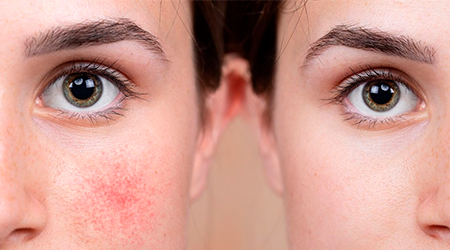Rosacea can affect people with all skin types, from dry to oily. With a skin disease, you can successfully cope, you need a properly selected drug regimen for the treatment of rosacea. You will also need to buy professional cosmetics for daily care.
Skin affected by rosacea is usually sensitive and needs to be taken care of, so having proper care is the key to keeping the skin in good condition.
What is rosacea
Rosacea is an inflammatory skin condition that can lead to redness, pustules, and dilated blood vessels. Rosacea is considered an incurable autoinflammatory skin disease. Characteristically affects the central region of the face, mainly the forehead, cheeks, chin and lower half of the nose. It usually appears in people with fair skin. Rosacea can be mistaken for acne, eczema, or an allergic skin reaction.
The disease is characterized by a set of symptoms including facial erythema and telangiectasias, papules and pustules, and swelling of the face, usually occurring in the central part of the face around the nose, cheeks, forehead, and chin. According to the presentation of symptoms, they can be further divided into four subtypes, including erythematotelangiectatic (erythema, redness, telangiectasias), pustular rosacea (erythema, swelling, acne-like lesions), mucosal rosacea (rhinophymatous changes), and ocular, which can cause significant inflammation leading to dryness, redness and irritation of the eyes, leading to changes and even damage to vision after chronic inflammation of the cornea.
The first symptoms of rosacea include:
- redness;
- skin bumps and pimples;
- visible blood vessels;
- eye irritation;
- skin thickening.
Causes of Rosacea
The exact cause of rosacea is unknown, but it may be due to a combination of hereditary and environmental factors. A number of factors can trigger outbreaks, including:
- hot drinks and spicy food;
- red wine and other alcoholic drinks;
- high temperatures;
- stress;
- physical activity;
- medicines that dilate blood vessels, including some blood pressure medicines
- various cosmetics;
- risk factors.
Of fundamental importance is that clinical studies have shown that rosacea can occur in women three times more often than in men. What is rosacea in women? Many women are first diagnosed during menopause. This can be caused by redness, which is often associated with hormonal changes.
Women with rosacea are also more likely to get migraines. The researchers suggested that the cause of this phenomenon may be changes in vascular reactivity caused by age-related changes in sex hormones.
How to treat razacea
When developing a therapeutic approach, it is also important that physicians not only determine the severity of the disease, but also ask the patient about their perception of the severity of the disease and what worries them most about the disease process. These two principles, in turn, can help guide the development of a therapeutic rosacea treatment regimen.
What not to do with rosacea? A rosacea diet focused on foods that relieve flare-ups containing high levels of acid, spices and refined sugars are among the things to avoid.
Rosacea how to treat? Proper skin hygiene, as well as lifestyle changes that include avoiding potential precipitating and aggravating factors, can help mitigate the severity of the condition. Avoid chemical or physical exfoliators and alcohol-based products, use moisturizers, wash your face with mild products, and use sunscreen with an SPF of 30 or higher, which can provide UV protection.
Cosmetics, the main ingredients of which are herbal ingredients, antioxidants and natural plant extracts, as well as amino acids.
A number of topical preparations can be used to treat persistent erythema, telangiectasias, and redness, including brimonidine gel 0.33%, an alpha-2 adrenoceptor agonist, and oxymetazoline cream 1%, an alpha-1 adrenoceptor agonist, both aimed at constricting facial blood vessels. Laser and light therapy, including pulsed dye and potassium titanyl phosphate lasers, as well as intense pulsed light, have also been shown to be effective in reducing erythema and some degree of redness, eliminating telangiectasias, and improving quality of life.
Currently, a number of topical and first-line oral agents are used to treat papules and pustules, including topical ivermectin cream 1%, azelaic acid 15%, and metronidazole gel, cream or lotion 0.75%. Other medications that have also been shown to be effective include 1% clindamycin gel with and without 5% benzoyl peroxide, erythromycin, minocycline, permethrin, and topical retinoids. In more severe cases, various combinations of topical and oral medications are also used.
Monomolecules, in particular No. 17 anti-stress for sensitive skin from ResedaOdor, will help in proper care.
People with rosacea may need medicated creams or ointments, laser or light therapy, or oral antibiotics. Either way, following a good skin care regimen, limiting sun exposure, and avoiding other irritants is key.

